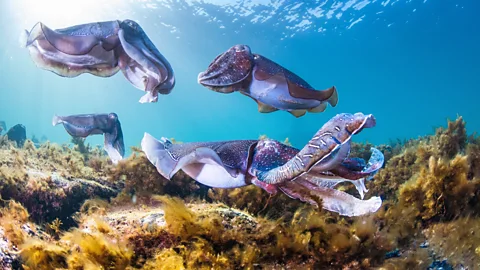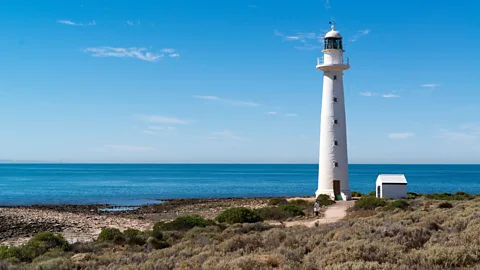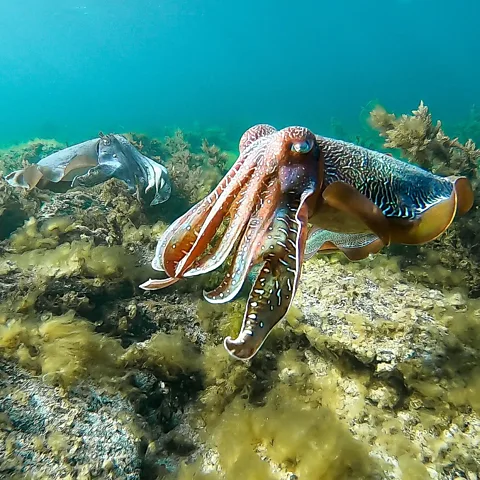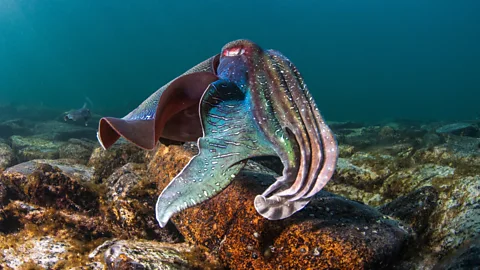Australia's X-rated underwater show
 Carl Charter
Carl CharterEach year, the small South Australian town of Whyalla becomes home to one of the most spectacular underwater events: the spawning of the giant Australian cuttlefish.
"First time you go and put your head under the water and see hundreds and hundreds of cuttlefish in this one little area, it just looks like a chaotic kaleidoscope. What the hell is going on here?" said Tony Bramley.
As owner of Whyalla Diving Services and a decades-long advocate for the Giant Australian cuttlefish, Bramley has observed the frenzied and colourful cuttlefish mating that occurs in South Australia's Upper Spencer Marine Gulf Park for years. Once only of interest to fishermen and local scuba divers – who would spread the word to one another that "the cuttles are in" – this marine phenomenon now attracts tourists and researchers from across the world. It's a welcome boost to the small steelworks town of Whyalla, on South Australia's Eyre Peninsula.
A type of marine invertebrate closely related to the octopus, cuttlefish are whip-smart molluscs that can change colour and texture instantly. They've been known to solve puzzles, and can hypnotise their prey by turning their bodies into strobe lights, rapidly pulsing colour through their skin to distract and stun an unsuspecting crab or fish. Their camouflage skills put chameleons to shame, and have even attracted the attention of the US military, who have researched the colour-changing abilities of cuttlefish with the hopes of replicating their techniques for army use. If that's not unusual enough, their mating behaviours are strange, to say the least.
From May to September each year, hundreds of thousands of Giant Australian cuttlefish gather in the waters just off Point Lowly, in the Upper Spencer Gulf, for the sole purpose of mating. Welcome to nature's most flamboyant underwater sex show.
 South Australian Tourism Commission
South Australian Tourism CommissionThe largest cuttlefish in the world are found throughout southern Australian waters, but only in Whyalla do they gather in high numbers for mating. "An estimate of cuttlefish numbers on the breeding aggregation for 2020 was 247,000, the highest on record," said Professor Bronwyn M Gillanders, a prominent cuttlefish researcher and Head of School, Biological Sciences at the University of Adelaide. "This number is reported but we know that it's likely an underestimate."
According to Gillanders, Whyalla attracts cuttlefish due to its unique marine landscape, with the Upper Spencer Gulf offering plenty of rocky ledges that the females use to lay their eggs. While cuttlefish mate elsewhere, the Spencer Gulf is home to the largest-known aggregation on the planet – there's nowhere else in the world where swimmers can observe such spectacular and strange mating behaviours en masse, including pulsating colour changes and males disguising themselves as females.
No-one ever said finding a partner was easy – and these cuttlefish are single and ready to mingle – but first, these unusual creatures need to get here. Bramley explained that some of the cuttlefish have been tagged, revealing that some are travelling from at least 65km south of the town and others 35km to the north to get to the breeding grounds in the Upper Spencer Gulf.
You may also be interested in:
• Australia's remarkable animal discovery
Arriving in Whyalla, it's easy to observe the cuttlefish as either a snorkeller or diver, with the cephalopods found in just 2-6m of water, right off the shore. While the water is calm, it's not warm. "You've got to really dress for the occasion," laughed Bramley. With ocean temperatures hovering around 10-16C, I came prepared with a thick wetsuit, hood, gloves and booties. Even still, the chill hit me like a ton of bricks – but once I was in the water, I had a front-row ticket to the most incredible show in town.
 Chris Bell
Chris BellOnce my eyes adjusted underwater, I realised I was surrounded by cuttlefish – and they didn't seem bothered in the slightest to have a human watching their most intimate moments. With vibrantly pulsating rainbows of purple, orange, turquoise and pink and tentacles everywhere, it took me some time to make sense of this cephalopod foreplay, as cuttlefish have more than a few mating tricks up their tentacles.
In an environment where males can outnumber females 10 to one, competition is fierce to pass on one's genes. In most species, size matters: large, aggressive males fight off their rivals to win the chance to mate. This is seen in cuttlefish as well, with large males known to wrestle one another for dominance in the presence of a female.
For any other species, this means the smaller males miss out. But cuttlefish aren't like any other animal. They've figured out that if you want to impress a lover, you need to think outside the box.
"The smaller males have a conundrum on their hands, because they know they can't win against these much larger males," explained Sarah McAnulty, squid biologist at the University of Connecticut. "They have devised an alternate approach – masquerading as females to avoid the battle altogether."
In perhaps the most fascinating mating behaviour of any species, smaller males can fade their translucent colouring and switch to the mottled maroons and whites of a female, before tucking their billowy arms up into their bodies. This makes them appear female, and as the burly males are busy fighting it out and leaving their potential partner unguarded, these "little sneakers", as Bramley affectionately called them," dart past them to get access to the female and then rapidly change their colouring back to male. A win for the clever underdog.
 Carl Charter
Carl CharterThe ensuing awkward-looking, head-to-head spectacle – if she decides to mate – might make you wonder if the cuttlefish have been taking notes from an adult film. During the tangled twist of tentacles, the cuttlefish connect and the male deposits his sperm packet in the female's mouth, using a specially designed arm known as the hectocotylus. The female then holds onto the sperm until she's ready to lay her eggs.
The female mates with multiple males and can use a mix of different sperm deposits for her clutch. "It's the ultimate rebuttal to putting all your eggs in one basket," said McAnulty.
Interestingly, the females prefer the smaller males over their beefy counterparts, according to McAnulty, indicating they're selecting brains over brawn. "Studies have even shown that when the females go to lay their eggs, they will give a larger proportion of fatherhood to those sneaky males," she said. "So, when we ask ourselves how those darn cephalopods got so smart? Well, they're sexually selecting for it!"
While there's no shortage of X-rated action under the water, it hasn't always been that way. In recent decades, overfishing in the region reduced the local cuttlefish population and spurred locals to take action. This led to the creation of a fishing exclusion zone in 2013 along the Upper Spencer Gulf during mating season. In the late 1990s, aggregation numbers were at their lowest, with Bramley estimating only 30,000-40,000 cuttlefish were present in 1999. In a twist of fate, the decline of the cuttlefish population attracted media attention. Once word got out about Whyalla's incredible cephalopods, the region slowly started to attract divers and tourists during the early 2000s, keen to observe what was then a relatively unknown marine phenomenon.
 Carl Charter
Carl CharterOver the last several years, peak cuttlefish season has resulted in hotels and restaurants enjoying full capacity, and the injection of tourism funds has been a welcome boost to an economy mainly reliant on steel production. While there's been talk of building more hotels to handle an influx of tourists, cuttlefish season only lasts three to four months – so how do tourism operators sustain themselves during the rest of the year?
One solution the town hopes will help is improved infrastructure, with a $4m Cuttlefish Sanctuary Tourism and Conservation Project grant announced in 2021. This will help the town manage additional visitors each season and promote Whyalla as a nature tourism destination with the help of improved beach access and walking paths, better signage, the addition of more native vegetation and increased protection for the area's delicate ecosystems.
While cuttlefish tourism in Whyalla is only in its second decade, the city hopes it will become a viable long-term income source.
As for the cuttlefish themselves, we can only hope they continue their ostentatious, sexy shenanigans, proving that life can be as colourful and wild as you want it to be.
Nature's Curiosities is a BBC Travel series that offers a close-up look at the natural world, taking adventurous travellers on an unexpected journey of exploration.
---
Join more than three million BBC Travel fans by liking us on Facebook, or follow us on Twitter and Instagram.
If you liked this story, sign up for the weekly bbc.com features newsletter called "The Essential List". A handpicked selection of stories from BBC Future, Culture, Worklife and Travel, delivered to your inbox every Friday.
{"image":{"pid":""}}
